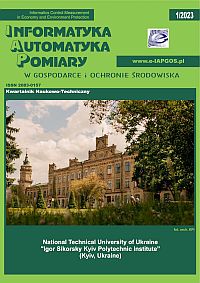APPLICATION OF EXPLAINABLE ARTIFICIAL INTELLIGENCE IN SOFTWARE BUG CLASSIFICATION
Article Sidebar
Open full text
Issue Vol. 13 No. 1 (2023)
-
AN ENHANCED DIFFERENTIAL EVOLUTION ALGORITHM WITH ADAPTIVE WEIGHT BOUNDS FOR EFFICIENT TRAINING OF NEURAL NETWORKS
Saithip Limtrakul, Jeerayut Wetweerapong4-13
-
APPLICATION OF EXPLAINABLE ARTIFICIAL INTELLIGENCE IN SOFTWARE BUG CLASSIFICATION
Łukasz Chmielowski, Michał Kucharzak, Robert Burduk14-17
-
AUTOMATIC DETECTION OF ALZHEIMER'S DISEASE BASED ON ARTIFICIAL INTELLIGENCE
Achraf Benba, Abdelilah Kerchaoui18-21
-
IMPLEMENTATION OF AN ARTIFICIAL INTELLIGENCE-BASED ECG ACQUISITION SYSTEM FOR THE DETECTION OF CARDIAC ABNORMALITIES
Achraf Benba, Fatima Zahra El Attaoui, Sara Sandabad22-25
-
DEVELOPMENT AND MODELING OF THE ANTENNA SYSTEM THE DIRECTION FINDER UNMANNED AERIAL VEHICLE
Juliy Boiko, Oleksiy Polikarovskykh, Vitalii Tkachuk26-32
-
SENSOR PLATFORM OF INDUSTRIAL TOMOGRAPHY FOR DIAGNOSTICS AND CONTROL OF TECHNOLOGICAL PROCESSES
Krzysztof Król, Tomasz Rymarczyk, Konrad Niderla, Edward Kozłowski33-37
-
FEATURES OF THE IMPLEMENTATION OF COMPUTER VISION IN THE PROBLEMS OF AUTOMATED PRODUCT QUALITY CONTROL
Nataliia Stelmakh, Ihor Mastenko, Olga Sulima, Tetiana Rudyk38-41
-
SELF-OSCILLATING PARAMETRIC HUMIDITY SENSOR WITH FREQUENCY OUTPUT SIGNAL
Iaroslav Osadchuk, Alexander Osadchuk, Vladimir Osadchuk, Lyudmila Krylik42-49
-
DEVELOPMENT OF A MODIFIED METHOD OF NETWORK TRAFFIC FORMING
Valeriy Kozlovskiy, Natalia Yakymchuk, Yosyp Selepyna, Serhii Moroz, Anatolii Tkachuk50-53
-
DIGITALIZATION OF ENTERPRISE WITH ENSURING STABILITY AND RELIABILITY
Gulnar Balakayeva, Paul Ezhilchelvan, Yerlan Makashev, Christofer Phillips, Dauren Darkenbayev, Kalamkas Nurlybayeva54-57
-
MODIFICATIONS OF EVANS PRICE EQUILIBRIUM MODEL
Serhii Zabolotnii, Sergii Mogilei58-63
-
A COMPARATIVE STUDY OF VARIOUS MODELS OF EQUIVALENT PLASTIC STRAIN TO FRACTURE
Volodymyr Mykhalevych, Yurii Dobraniuk, Victor Matviichuk, Volodymyr Kraievskyi, Oksana Тiutiunnyk, Saule Smailova, Ainur Kozbakova64-70
Archives
-
Vol. 15 No. 3
2025-09-30 24
-
Vol. 15 No. 2
2025-06-27 24
-
Vol. 15 No. 1
2025-03-31 26
-
Vol. 14 No. 4
2024-12-21 25
-
Vol. 14 No. 3
2024-09-30 24
-
Vol. 14 No. 2
2024-06-30 24
-
Vol. 14 No. 1
2024-03-31 23
-
Vol. 13 No. 4
2023-12-20 24
-
Vol. 13 No. 3
2023-09-30 25
-
Vol. 13 No. 2
2023-06-30 14
-
Vol. 13 No. 1
2023-03-31 12
-
Vol. 12 No. 4
2022-12-30 16
-
Vol. 12 No. 3
2022-09-30 15
-
Vol. 12 No. 2
2022-06-30 16
-
Vol. 12 No. 1
2022-03-31 9
-
Vol. 11 No. 4
2021-12-20 15
-
Vol. 11 No. 3
2021-09-30 10
-
Vol. 11 No. 2
2021-06-30 11
-
Vol. 11 No. 1
2021-03-31 14
Main Article Content
DOI
Authors
Abstract
Fault management is an expensive process and analyzing data manually requires a lot of resources. Modern software bug tracking systems may be armed with automated bug report assignment functionality that facilitates bug classification or bug assignment to proper development group. For supporting decision systems, it would be beneficial to introduce information related to explainability. The purpose of this work is to evaluate the use of explainable artificial intelligence (XAI) in processes related to software development and bug classification based on bug reports created by either software testers or software users. The research was conducted on two different datasets. The first one is related to classification of security vs non-security bug reports. It comes from a telecommunication company which develops software and hardware solutions for mobile operators. The second dataset contains a list of software bugs taken from an opensource project. In this dataset the task is to classify issues with one of following labels crash, memory, performance, and security. Studies on XAI-related algorithms show that there are no major differences in the results of the algorithms used when comparing them with others. Therefore, not only the users can obtain results with possible explanations or experts can verify model or its part before introducing into production, but also it does not provide degradation of accuracy. Studies showed that it could be put into practice, but it has not been done so far.
Keywords:
References
Aleithan R.: Explainable Just-In-Time Bug Prediction: Are We There Yet? 43rd International Conference on Software Engineering: Companion Proceedings (ICSE-Companion), 2021, 129–131 [http://doi.org/10.1109/ICSE-Companion52605.2021.00056]. DOI: https://doi.org/10.1109/ICSE-Companion52605.2021.00056
Anjali, Mohan D., Sardana N.: Visheshagya: Time based expertise modelfor bug report assignment. Ninth International Conference on Contemporary Computing (IC3), 2016, 1–6 [http://doi.org/10.1109/IC3.2016.7880218]. DOI: https://doi.org/10.1109/IC3.2016.7880218
Barredo Arrieta A. et al.: Explainable Artificial Intelligence (XAI): Concepts, taxonomies, opportunities and challenges toward responsible AI. Information Fusion 58, 2020, 82–115 [http://doi.org/10.1016/j.inffus.2019.12.012]. DOI: https://doi.org/10.1016/j.inffus.2019.12.012
Behl D., Handa S., Arora A.: A bug Mining tool to identify and analyze security bugs using Naive Bayes and TF-IDF. International Conference on Reliability Optimization and Information Technology (ICROIT), 2014, 294–299 [http://doi.org/10.1109/ICROIT.2014.6798341]. DOI: https://doi.org/10.1109/ICROIT.2014.6798341
Carlevaro A., Maurizio M.: A New SVDD Approach to Reliable and Explainable AI. IEEE Intelligent Systems 37.2, 2022, 55–68 [http://doi.org/10.1109/ACCESS.2022.3180026]. DOI: https://doi.org/10.1109/MIS.2021.3123669
Carlevaro A. et al.: Counterfactual Building and Evaluation via eXplainable Support Vector Data Description. IEEE Access 10, 2022, [http://doi.org/10.1109/MIS.2021.3123669]. DOI: https://doi.org/10.1109/ACCESS.2022.3180026
Castelluccio M. et al.: bugbug. Available online: https://github.com/mozilla/bugbug (accessed on 02.11.2022).
Chmielowski L., Kucharzak M.: Impact of Software Bug Report Preprocessing and ectorization on Bug Assignment Accuracy. Progress in Image Processing, Pattern Recognition and Communication Systems. Edited by Michal Choraś, et al.: Springer International Publishing, Cham 2022, 153–162 [http://doi.org/10.1007/978-3-030-81523-3_15]. DOI: https://doi.org/10.1007/978-3-030-81523-3_15
Choquette-Choo C. A. et al.: A Multi-label, Dual-Output Deep Neural Network for Automated Bug Triaging. 18th IEEE International Conference On Machine Learning And Applications (ICMLA), 2019, 937–944, [http://doi.org/10.1109/ICMLA.2019.00161]. DOI: https://doi.org/10.1109/ICMLA.2019.00161
Gujral S., et al.: Classifying bug severity using dictionary based approach. International Conference on Futuristic Trends on Computational Analysis and Knowledge Management (ABLAZE), 2015, 599–602, [http://doi.org/10.1109/ABLAZE.2015.7154933]. DOI: https://doi.org/10.1109/ABLAZE.2015.7154933
Khanan C. et al.: JITBot: An Explainable Just-In-Time Defect Prediction Bot. 35th IEEE/ACM International Conference on Automated Software Engineering (ASE), 2020, 1336–1339. DOI: https://doi.org/10.1145/3324884.3415295
Lamkanfi A., Pérez J., Demeyer S.: The Eclipse and Mozilla defect tracking dataset: A genuine dataset for mining bug information. 10th Working Conference on Mining Software Repositories (MSR), 2013, 203–206 [http://doi.org/10.1109/MSR.2013.6624028]. DOI: https://doi.org/10.1109/MSR.2013.6624028
Matzka S.: Explainable Artificial Intelligence for Predictive Maintenance Applications. Third International Conference on Artificial Intelligence for Industries (AI4I), 2020, 69–74, [https://doi.org/10.1109/AI4I49448.2020.00023]. DOI: https://doi.org/10.1109/AI4I49448.2020.00023
Monperrus M.: Explainable Software Bot Contributions: Case Study of Automated Bug Fixes. IEEE/ACM 1st International Workshop on Bots in Software Engineering (BotSE), 2019, 12–15, [http://doi.org/10.1109/BotSE.2019.00010]. DOI: https://doi.org/10.1109/BotSE.2019.00010
Raschka S.: 5x2cv paired ttest. Available online: https://rasbt.github.io/mlxtend/user_guide/evaluate/paired_ttest_5x2cv (accessed on 04.01.2021). DOI: https://doi.org/10.1093/noajnl/vdaa143.020
Vilone G. Longo L.: Explainable Artificial Intelligence: a Systematic Review. 2020, [http://doi.org/10.48550/arXiv.2006.00093].
Article Details
Abstract views: 867
License

This work is licensed under a Creative Commons Attribution-ShareAlike 4.0 International License.
Łukasz Chmielowski, Nokia Solutions and Networks sp. z o.o.

Łukasz Chmielowski received a M.Sc. degree with distinction in Computer Science with specialization in Intelligent Information Systems. He is currently working towards Ph.D. in Information and Communication Technology at Wroclaw University of Science and Technology (Poland). He is with the Nokia Solutions and Networks sp. z o.o. (Poland) for five years. He is working with machine learning techniques related to natural language processing and software bug assignment.
Michał Kucharzak, Nokia Solutions and Networks sp. z o.o.

Michał Kucharzak received his Ph.D. in computer science in area of network optimization. In recent years, he cooperated with numerous R&D centers and has been a member of reviewer committees for many international journals, program, and technical committees for various conferences as well. His current research interests are primarily in the areas of network modeling and network optimization with special regard to overlays, simulations, design of efficient algorithms and wireless system protocols, including software testing and quality assurance.
Robert Burduk, Wroclaw University of Science and Technology

Robert Burduk is Professor of Computer Science in the Department of Systems and Computer Networks, Faculty of Information and Communication Technology, Wroclaw University of Science and Technology, Poland. He received an Ph.D. and D.Sc. degrees in Computer Science in 2003 and 2014 respectively. His research interests cover among the others: machine learning, classifier selection algorithms and multiple classifier systems. He serves on program committees of numerous international conferences, published over 100 papers and edited 5 books.






